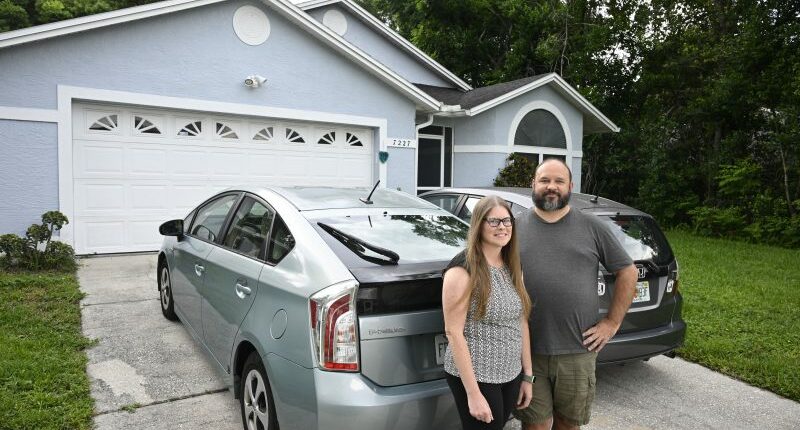Share this @internewscast.com
NEW YORK (AP) — During her childhood, Heidi Barley witnessed her family use food stamps to purchase groceries. As a college student, financial constraints forced her to abandon her studies. In her twenties, already struggling financially, she had to endure a salary reduction down to $34,000 annually.
But this summer, the 41-year-old hit a milestone that long felt out of reach: She became a millionaire.
An increasing number of ordinary Americans now claim a net worth in the seven-figure range, once associated exclusively with celebrities and top executives. However, as the millionaire population grows, the essence of the status is evolving, along with the perception of true wealth.
“Being a millionaire used to conjure images of an opulent figure like Rich Uncle Pennybags with his top hat,” states Michael Ashley Schulman, the chief investment officer at Running Point Capital Advisors, a wealth management firm based in El Segundo, California. “Nowadays, it signifies a middle-class affluence, secure financially but still distant from the luxury of private jets.”
Due to inflation, soaring property values, and a long-standing trend of average individuals investing in stocks, millions have entered the realm of millionaire status. A report from June by Swiss bank UBS revealed that about 10% of American adults are part of this seven-figure circle, with 1,000 new millionaires emerging every day last year.
Three decades ago, the IRS documented 1.6 million Americans having a net worth of at least $1 million. In contrast, UBS, utilizing information from the United Nations, World Bank, International Monetary Fund, and global central banks, estimated that last year there were 23.8 million millionaires in the U.S., showing a nearly 15-fold rise.
The growing number of millionaires highlights the increasing disparity between rich and poor. The top 10% of Americans possess two-thirds of the nation’s household wealth, averaging $8.1 million each, according to the Federal Reserve. Meanwhile, the bottom half holds merely 3% of the wealth, with an average worth of $60,000 per individual.
Federal Reserve data also shows there are differences by race. Asian people outpace white people in the U.S. in median wealth, while Black and Hispanic people trail in their net worth.
Barley was working as a journalist when her newspaper ended its pension program and she got a lump-sum payout of about $5,000. A colleague convinced her to invest it in a retirement account, and ever since, she’s stashed away whatever she could. The investments dipped at first during the Great Recession but eventually started growing. In time, she came to find catharsis in amassing savings, going home and checking her account balances when she had a tough day at work.

Last month, after one such day, she realized the moment had come.
“Did you know that we’re millionaires?” she asked her husband.
“Good job, honey,” Barley says he replied, unfazed.
It brought no immediate change. Like many millionaires, much of her wealth is in long-term investments and her home, not easy-to-access cash. She still lives in her modest Orlando, Florida, house, socks away half her paycheck, fills the napkin holder with takeout napkins and lines trash cans with grocery bags.
Still, Barley says it feels powerful to cross a threshold she never imagined reaching as a child.
“But it’s not as glamorous as the ideas in your head,” she says.
All wealth is relative. To thousandaires, $1 million is the stuff of dreams. To billionaires, it’s a rounding error. Either way, it takes twice as much cash today to match the buying power of 30 years ago.
A net worth of $1 million in 1995 is equivalent to about $2.1 million today, according to the U.S. Bureau of Labor Statistics.
A seven-figure net worth is, to some, as outdated a yardstick as a six-figure salary. Nonetheless, “millionaire” is peppered in everything from politics to popular music as shorthand for rich.
“It’s a nice round number, but it’s a point in a longer journey,” says Dan Uden, a 41-year-old from Providence, Rhode Island, who works in information technology and who hit the million-dollar mark last month. “It definitely gives you some room to breathe.”
No other country comes close to the U.S. in the sheer number of millionaires, though relative to population, UBS found Switzerland and Luxembourg had higher rates.
Kenneth Carow, a finance professor at Indiana University’s Kelley School of Business, says commonalities emerge among today’s millionaires. The vast majority own stocks and a home. Most live below their means. They value education and teach financial responsibility to their children.
“The dream of becoming a millionaire,” Carow says, “has become more obtainable.”
Jim Wang, 45, a software engineer-turned finance blogger from Fulton, Maryland, says even if hitting $1 million was essentially “a non-event” for him and his wife, it still held weight for him as the son of immigrants who saved money by turning the heat off on winter nights.
The private jets he envisioned as a kid may not have materialized at the million-dollar threshold, but he still sees it as a marker that brings a certain level of security.
“It’s possible, even with a regular job,” he says. “You just have to be diligent and consistent.”
The resilience of financial markets and the ease of investing in broad-based, low-fee index funds has fueled the balances of many millionaires who don’t earn massive salaries or inherit family fortunes.
Among them is a burgeoning community of younger millionaires born out of the movement known as FIRE, for Financial Independence Retire Early.
Jason Breck, 48, of Fishers, Indiana, embraced FIRE and reached the million-dollar mark nine years ago. He promptly quit his job in automotive marketing, where he generally earned around $60,000 a year but managed to stow away around 70% of his pay.
Now, Breck and his wife spend several months a year traveling. Despite being retired, they continue to grow their balance by sticking to a tight budget and keeping expenses to $1,500 a month when they’re in the U.S and a few hundred dollars more when they travel.
Hitting their goal hasn’t translated to luxury. There is no lawn crew to cut the grass, no Netflix or Amazon Prime, no Uber Eats. They fly economy. They drive a 2005 Toyota.
“It’s not a golden ticket like it was in the past,” Breck says. “For us, a million dollars buys us freedom and peace of mind. We’re not yacht rich, but for us, we’re time rich.”













